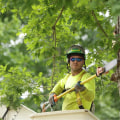Pruning during the growing season always stimulates new growth, and while it can cause a tree to look stressed in the summer heat, it is not always a bad idea. It depends on the type of tree and the situation. Certain trees should always be pruned in summer, certain trees should never be pruned in summer, and unavoidable situations where you need to prune a tree no matter what time of year you are in. Knowing when and how to prune is essential for keeping trees healthy and avoiding killing them.
Experienced gardeners use summer pruning to direct growth by slowing down the development of a tree or branch. The best time for this form of pruning is right after the seasonal growth has reached its peak. By eliminating the total leaf area of the plant, the amount of nutrients sent to the roots and the overall growth of the tree is reduced. Be sure to cut a few inches off the stem or main branches to leave as much nutrients to the tree to survive summer and winter.
In these cases where safety is compromised, tree pruning in summer is not only justified, but also necessary. If the tree seems stressed in the summer or early in the season, pruning it could help keep it healthy, as it will have less foliage to maintain. I recommend leaving large, established shade trees to qualified arborists and tree care professionals. You need to know how much can be pruned when the tree is barely growing and has to adapt to a new environment.
So if you're wondering if it's okay to prune trees in summer, just know that summer pruning is mainly for shaping and creating a solid structure. You probably want to prune a lot of trees now, unless it's a fruit tree or poses a safety hazard. It is advisable to prune trees that produce sap, such as walnuts and maples, in summer, because this is the time when they are least likely to lose too much sap (water). Overdrying: Summer temperatures and the intensity of the sun will cause it to dry out too much if a tree is pruned significantly.
Regular pruning throughout the life of a tree reduces the amount of work required and stress on the tree. It will also be easier for you to identify damaged branches and determine the extent to which the tree should be pruned and kept healthy, as the branches will be dry and there will be less foliage in summer. Pruning these trees in spring or winter is not a good idea, as they will end up losing a lot of water in the form of sap (in spring) or vital nutrients needed during dormancy (in winter). And when you transplant a tree, you need to cut 1/3 of the top so that the tree can survive the “impact of being transplanted”.
Keep in mind that mature evergreens rarely require pruning, unless you do it to remove dead wood, shape the crown, or remove weakened branches after a storm.


